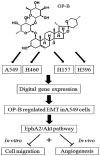Ophiopogonin B suppresses the metastasis and angiogenesis of A549 cells in vitro and in vivo by inhibiting the EphA2/Akt signaling pathway
- PMID: 29956803
- PMCID: PMC6072400
- DOI: 10.3892/or.2018.6531
Ophiopogonin B suppresses the metastasis and angiogenesis of A549 cells in vitro and in vivo by inhibiting the EphA2/Akt signaling pathway
Erratum in
-
[Corrigendum] Ophiopogonin B suppresses the metastasis and angiogenesis of A549 cells in vitro and in vivo by inhibiting the EphA2/Akt signaling pathway.Oncol Rep. 2024 Sep;52(3):115. doi: 10.3892/or.2024.8774. Epub 2024 Jul 12. Oncol Rep. 2024. PMID: 38994771 Free PMC article.
Abstract
Lung adenocarcinoma is the most common metastatic cancer, and is associated with high patient mortality. Therefore, investigation of anti‑metastatic treatments for lung adenocarcinoma is crucial. Ophiopogonin B (OP‑B) is a bioactive component of Radix Ophiopogon Japonicus, which is often used in Chinese traditional medicine to treat pulmonary disease. Screening of transcriptome and digital gene expression (DGE) profiling data in NSCLC cell lines showed that OP‑B regulated the epithelial‑mesenchymal transition (EMT) pathway in A549 cells. Further results showed that 10 µmol/l OP‑B downregulated EphA2 expression and phosphorylation (Ser897) in A549 cells but upregulated them in NCI‑H460 cells. Meanwhile, the Ras/ERK pathway was unaffected in A549 cells and stimulated in NCI‑H460 cells. More importantly, detection of the EMT pathway showed that OP‑B treatment increased the epithelial markers ZO‑1 and E‑cadherin and decreased the expression of the mesenchymal marker N‑cadherin and the transcriptional repressors Snail, Slug and ZEB1. Furthermore, through Transwell migration and scratch wound healing assays, we found that 10 µmol/l OP‑B significantly reduced the invasion and migration of A549 cells. In vivo, we found that 75 mg/kg OP‑B inhibited A549 cell metastasis in a pulmonary metastasis nude mouse model. In addition, we also found that 10 µmol/l OP‑B significantly inhibited tube formation in EA.hy926 cells. The expression of VEGFR2 and Tie‑2, the phosphorylation of Akt (S473) and PLC (S1248), and the levels of EphA2 and phosphorylated EphA2 (S897) were all inhibited by OP‑B in this cell line. In vivo, using a Matrigel plug assay, we found that OP‑B inhibited angiogenesis and the hemoglobin content of A549 transplanted tumors. Taken together, OP‑B inhibited the metastasis and angiogenesis of A549 cells by inhibiting EphA2/Akt and the corresponding pathway. The investigation gives new recognition to the anticancer mechanism of OP‑B in NSCLC and this compound is a promising inhibitor of metastasis and angiogenesis of lung adenocarcinoma cells.
Figures







References
-
- Collins LG, Haines C, Perkel R, Enck RE. Lung cancer: Diagnosis and management. Am Fam Physician. 2007;75:56–63. - PubMed
MeSH terms
Substances
LinkOut - more resources
Full Text Sources
Other Literature Sources
Molecular Biology Databases
Research Materials
Miscellaneous

